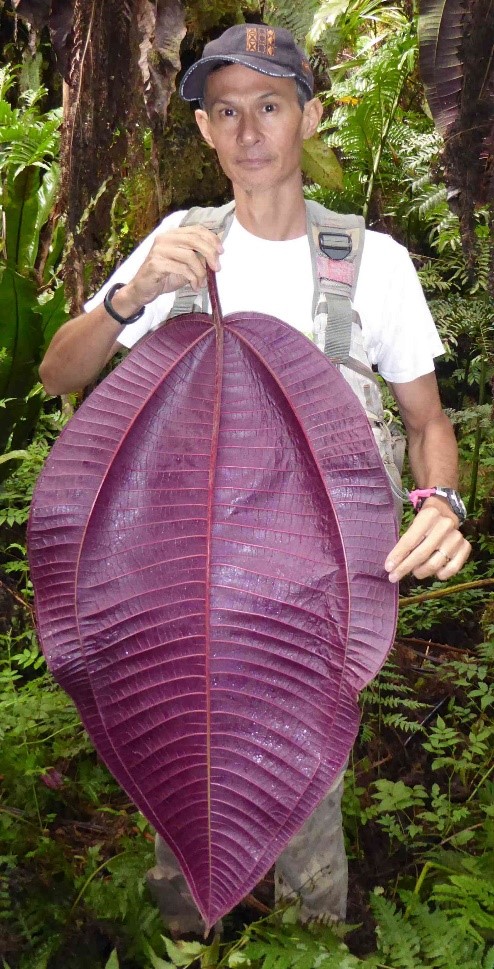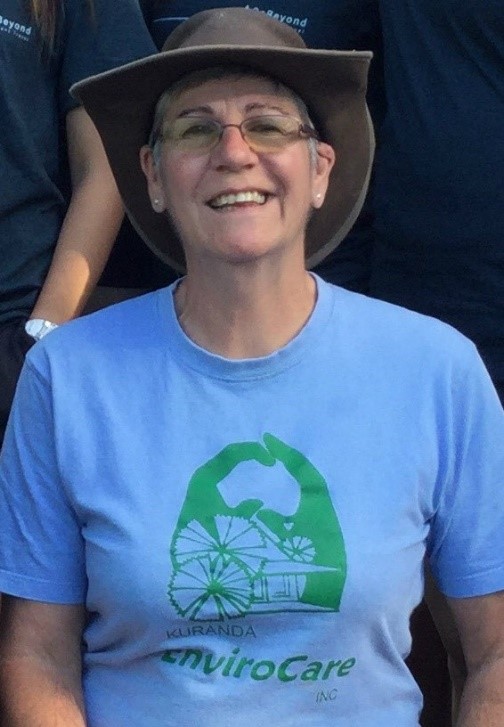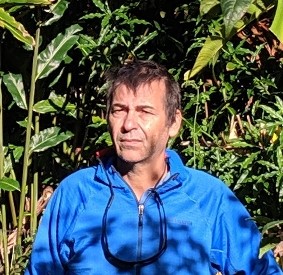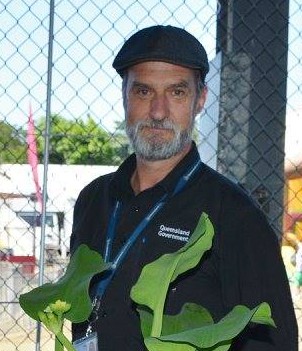Miconia: “Purple plague’s” threat to the Daintree
Miconia, in Tahiti it’s called ‘green cancer’ and in Hawaii it’s called the ‘purple plague’. This episode focuses on the threat this fast growing invasive plant poses to Far North Queensland’s ancient and spectacular rainforests. Research Management Officer with French Polynesia’s Department of Research Doctor Jean-Yves Meyer talks about the devastating impact miconia has had on Tahiti, Kuranda Envirocare President Cathy Retter shares her concerns that Queensland’s Wet Tropics World Heritage will be changed forever if miconia took hold there, local businessman Can Kara talks about his experience after miconia was found on his property and Biosecurity Queensland’s Kim Badcock explains what is being done to protect Queensland’s world renowned rainforests from the ravages of miconia.
Meet our guests
Transcript
Program intro: Welcome to Turf and Surf, powered by Queensland’s Department of Agriculture and Fisheries, shaping and protecting food and fibre for tomorrow’s Queensland.
Host: The fragile ecosystems of Far North Queensland’s ancient and spectacular rainforests are under threat from miconia, a fast growing invasive plant with the real potential to rapidly devastate these world renowned rainforests. As these fragile ecosystems are a major tourist drawcard, it’s vital they’re protected from biosecurity threats from invasive plants such as miconia.
Hi, I’m Brad Muir. Today on Turf and Surf we look at the impact miconia has had overseas, its potential impact on Far North Queensland’s beautiful rainforests, and what is being done to help protect them from the ravages of this invasive plant.
Program segue: You’re listening to Turf and Surf, the official podcast of Queensland’s Department of Agriculture and Fisheries, shaping and protecting food and fibre for tomorrow’s Queensland.
Host: On this episode of Turf and Surf we’re looking at the effects of miconia on Far North Queensland’s ancient and spectacular rainforests.
Doctor Jean-Yves Meyer is a Research Management Officer with the government of French Polynesia’s Department of Research. Doctor Meyer is regarded as French Polynesia’s foremost miconia expert. Sadly, 70 per cent of Tahiti is now a forest of the invasive weed.
Thanks for your time Doctor Meyer. How was miconia introduced into Tahiti?
Doctor Jean-Yves Meyer: Miconia was introduced to Tahiti as the garden ornamental plant back in 1937, in a botanical garden.
Host: And so how did it spread from there?
Doctor Jean-Yves Meyer: We think that it spread with people who were propagating the plant, because it was so beautiful. So it was dispersed by people in other gardens, but also by natural dispersal, the miconia produces small fleshy fruit which are actively dispersed by birds.
Host: And that’s one of the aspects of miconia, isn’t it, it’s a very attractive plant, but it’s also very destructive.
Doctor Jean-Yves Meyer: Yes, it is. Today miconia has invaded the two-thirds of the island of Tahiti which is about 1000 square kilometres in size.
Host: So that’s a large area that it’s invaded. What impacts has miconia had on Tahiti’s ecosystem, its plants, its animals?
Doctor Jean-Yves Meyer: Miconia has two kinds of impact. A direct impact on the native forest, it has displaced the native forest, almost 100 plants which are pretty endemic to Tahiti are now considered endangered because of miconia.
And the second impact is on the watershed. We believe that miconia has caused and is still causing soil erosion. We noted very large landslides on steep slopes which are densely invaded by miconia, and this soil erosion has an impact also on from the river, the water quality and also down to the reef.
Host: So these are really some quite serious impacts on the local environment.
Doctor Jean-Yves Meyer: Yes, and it has also an impact on agricultural, especially locally cultivated plants in the wet valleys underneath the elevation plateaus, such as bananas or orange trees, which are almost extinct in Tahiti.
Host: So given the impacts on both the environment and the economy, what is being done in French Polynesia to address miconia?
Doctor Jean-Yves Meyer: Well, for the past 30 years, we tried to eradicate miconia on Tahiti and on other islands where it was found. But eradication is very difficult, so today we try to control or contain miconia in some specific areas by removing the young plants and also using chemicals.
Host: So do you think you’re winning the battle?
Doctor Jean-Yves Meyer: No, well, the battle is very difficult to win. We have also started a biological control program by introducing a fungal pathogen which is highly specific to miconia so it attacks only miconia and this small pathogen is causing a partial defoliation of the large miconia tree. So today, after almost 20 years of biocontrol, we’ve got very interesting results.
Host: So the prospects are looking good?
Doctor Jean-Yves Meyer: Yes, using biological control but only on very large infested areas. In other islands we are still trying to eradicate miconia, especially in cases where it’s not very abundant or very localised such as in the Marquesas so we’ve got very intensive control project on the island of Nuku Hiva and Fatu Hiva, where miconia is present but not very dense.
Program segue: This Turf and Surf podcast is powered by Queensland’s Department of Agriculture and Fisheries, shaping and protecting food and fibre for tomorrow’s Queensland.
Host: Cathy Retter is the President of Kuranda Envirocare, a group dedicated to protecting the natural environment of Kuranda and its environs. Cathy is concerned the Queensland’s Wet Tropics World Heritage would be changed forever if miconia took hold there.
Welcome Cathy. First of all, let’s talk a little bit about the work of Kuranda Envirocare. What do your people do?
Cathy Retter: Kuranda Envirocare is one of the Landcare organisations under the umbrella organisation of Landcare Australia and we focus on our local area.
We have a number of endangered species here and we focus on improving the habitat for those species and educating the community about the wonderful environment that we have, all its great things and also all the things that threaten it.
Host: So you’re very much invested in protecting the local environment.
Cathy Retter: Yes, we are and so we, as well as putting up trees there, we also need to actually focus on the threat, because sometimes we need to protect what we actually have, as well as enhancing and increasing it, we need to actually protect what we have.
Host: So Cathy, that’s a really good way to start talking about miconia and the threat that it poses to our rainforest. What is the threat that miconia poses?
Cathy Retter: Miconia, because of the size of the leaves and the dense shade which is can create, fact that it doesn’t mind to have its own little seedlings arising underneath the parent tree, unlike a number of other rainforest species which the seeds won’t germinate if they’re under the shade of the existing tree, there seems to be some block to that happening.
Sometimes seeds need to go through the gut of a bird and be transported elsewhere for them to actually germinate. But miconia creates this dense, dense shade wherever it arises and the leaves, the size of the leaves and the way the patterning on the leaves is very strong venation and the pleating on the leaves actually, and very long tips that they have, seems to channel water that falls towards the tip. And so you get a, like a little mini drainpipe from off your house roof and as you know, when water flows down your drainpipe and it hits the ground, it can cause quite a bit of erosion just at that point.
And so my understanding with miconia is that if you get these forests, they’re not very deep rooted and on steep slopes we really hope and know that our rainforest trees are putting the roots down deep and they’re really holding the slope together, which is why we don’t get a lot of erosion out of good rainforest. But with these things, they are shallow rooted and so with these erosion points all around them created by their own leaves, landslides can actually be caused.
Host: So they really do affect the natural habitat.
Cathy Retter: They certainly do Brad. We unfortunately have had over the past 40 years people bringing them into Kuranda I guess when biosecurity wasn’t so good or maybe there was not such restrictions on plants coming from other parts of the world and these ones have come in from Central America.
They get into this area, they love it between 300 and 1800 metres and we have just about the right rainfall here and plenty of disturbed areas too. Some species of miconia seem to invade really good rainforest but miconia calvescens seems to really like the disturbed areas.
Host: How easily spotted is miconia?
Cathy Retter: Well, when they’re little, and everything’s at your eye level, and apparently they can grow 1.5 metres a year, so you can have a nice little plant shoot up from the seed in your garden and it’ll be about your eye level.
So they are quite easy to spot aren’t they, we see things, anything from the ground up to just about our height but we’re not so good at moving our necks back. I know that when I was in someone’s kitchen after having learnt about miconia, a couple of weeks later I was standing at someone’s kitchen getting a glass of water, I looked out the window and low and behold there was a plant.
I couldn’t believe it. I asked the person about it, turned out it was one. And they very graciously took it out of their garden before someone had to come around and do exactly that.
Host: So that was growing right under the kitchen window?
Cathy Retter: It was, just in, on the edge of the forest, just out from about a couple of metres out from their kitchen window.
Host: Hidden in plain view as they say. And look, it’s not only average, every day people who have trouble identifying miconia, even people who work with it regularly don’t always see it.
Cathy Retter: No, that’s right. I was talking to somebody from the eradication program and they were up on Bellenden Ker and they were talking to me about the orchids that they have a passion for. And they said that though, because they were looking for miconia, they also related to me a little story about how the team of four were having a bit of a break, it had been quite a puff up to the ridge line, and one of the fellows in the team was leaning against a tree and my friend was looking around and looked back towards him and the fellow was saying to him oh well, there doesn’t seem to be any miconia around here, maybe we should move on.
My friend called back to him that perhaps he should just look up. And in fact, he was leaning against the trunk of a small miconia tree. Obviously a few years old and had gotten up above him and because where he was looking from about, you know, eye height, and maybe he was looking a bit higher, but he was looking out and not up, so didn’t spot it.
Host: So but people need to be aware of what they’re looking for. Cathy, how can people help in this battle against miconia?
Cathy Retter: Well, I think it’s really important that people know what it is that they’re looking for, like I say, it was only two weeks earlier that I had actually heard about miconia and been given a brochure and then there it was out that friend’s kitchen window.
So I think the thing we can do most successfully is actually spread the word about what to look for, and especially in places like Kuranda here where people have a penchant for swapping plants between each other and because we have a high number of birds, if there are mature trees around that, you know, with birds spreading the seeds, we certainly need to be very mindful.
It’s very important for people to actually recognise these plants so that when they’re, wherever they are, if they’re holidaying somewhere and they spot something that they think that could be, that they could actually talk to someone from biosecurity, let them know.
Host: So education, awareness and vigilance are the keys.
Cathy Retter: Yes, very much vigilance I think. Biosecurity really is all our responsibilities. Sure, we need people in the department to actually manage what’s coming in through our borders, but once things are here, really, it’s, you know, we have to be the eyes and ears of everybody on the ground and if we see anything unusual we should report it.
Host: Thanks for talking with me Cathy.
Can Kara runs a small fruit farm and Air B&B business on land adjoining the Daintree National Park. In 2006 miconia was found on Can’s property. Since then, Can has worked with Biosecurity Queensland to stop the weed spreading.
Thanks for joining us Can. Do you remember how the weed was discovered?
Can Kara: A couple of years ago first the biosecurity officer they visited us and they informed us about the threat and then they looked thoroughly through our property, this is about 20 hectare, and they discovered 10 to 15 trees and our property is directly joining the Daintree National Park. And our property is very close to the main infestation area which is probably 100 or 200 metres away.
Host: So you have a 20 hectare property, how much of it was affected?
Can Kara: Yes. You cannot say that how much, just it’s a threat of plants but they can spread very quick so if nothing would have been done or I would say easily 30 per cent.
Host: And what impact could that infestation have had on your businesses?
Can Kara: Oh, well, there are a couple of impacts that could be pretty serious. First, miconia is a very invasive plant and it takes very quickly over the native vegetation. And because we have a property which is surrounded by hills and slope, where we left the native vegetation, miconia would have taken over that and the first thing we would lose the biodiversity of plants and animals. And the biodiversity taken is a very important space to have a healthy soil for growing our fruit.
The other, bigger impact would be probably landslides. Miconia have a very shallow root system, so on the hills and slope, if miconia would take over there, it could lead to landslides and they are nearly impossible to fix. We could lose the steps to the property or the holiday rental and even lose the whole, whole house.
Host: That’s quite a serious impact on your businesses. So since you discovered the miconia, you’ve been working very closely with Biosecurity Queensland’s Tropical Weed Eradication Team, how have they helped you to rid the property of miconia?
Can Kara: Well, they come and check the property, because the seeds of miconia, they can stay up to 15 years fertile in the ground, so, and they are very quick growing plants, which get very quick, spread seeds again. So it’s very important that they come and re-check properties regular.
Host: Why else is it important?
Can Kara: Well, the main income for the Douglas Shire is tourism and there are two main reasons why people come to the Douglas Shire for tourism. That’s the Great Barrier Reef and the Daintree National Park. Both are well known over the world.
For the Great Barrier Reef there are currently massive programs on the way and a lot of media but I don’t think so the same amount gets done for the Daintree National Park and I think we have now a very good chance to protect the Daintree National Park from further threat.
Program segue: You’re listening to Turf and Surf, the official podcast of Queensland’s Department of Agriculture and Fisheries, shaping and protecting food and fibre for tomorrow’s Queensland.
Host: On this episode of Turf and Surf we’re talking about the threat posed to North Queensland’s world famous rainforests by the invasive weed miconia, and what’s being done to eradicate it.
Kim Badcock is an Engagement Officer with Biosecurity Queensland’s National Tropical Weeds Eradication Program, which is tasked with eradicating weeds such as miconia from Australia. Kim, thanks for joining us. What are the weeds targeted by the National Tropical Weeds Eradication Program?
Kim Badcock: Well, there’s a vine called miconia, an aquatic plant called limnocharis and three different types of miconia. Two of the miconia are shrubs but the other one it’s a tree and by far the most easily recognisable.
It is so famous it only has one name, we just call it miconia. It has huge leaves so they’re green on top, purple underneath and with three strong veins that run down the leaf.
Host: And why is there a particular focus on miconia?
Kim Badcock: Miconia has earned a really bad reputation overseas. In Tahiti it is called green cancer and in Hawaii it is called the purple plague. So you just know it is bad news for the environment. People from those countries said that if miconia ever reaches Australia, that we must do whatever it takes to eradicate it before it becomes established.
Now, miconia was brought here in the 1960s and was distributed fairly widely. It was grown in botanic gardens and then grown and sold in nurseries. By in 1997 it was declared and removed from nurseries, parks and gardens. So now we are just mopping it up where it has escaped to natural areas.
Host: What are the biosecurity implications for Queensland if miconia takes hold?
Kim Badcock: Look, miconia’s strategy for world domination is to make a lot of seeds that survive a long time in the soil. Therefore, when the conditions are just right, like some type of disturbance, the seeds quickly germinate with the extra sunlight.
Miconia grows really quickly up to one metre per year and those big leaves shade out everything that might have otherwise grown underneath it. This is how miconia ruins habitats.
Host: The idea of miconia dominating the world is pretty scary. What’s being done to eradicate it?
Kim Badcock: The Federal Government and four State Governments, Western Australia, Northern Territory, New South Wales and Queensland, contribute funds for an eradication program.
Now, the program follows strict guidelines in an agreed plan of action which is called a response plan. That is approved by a national committee of experts. So Biosecurity Queensland run the program and work with local governments and state and private land managers to search and destroy miconia.
So we’ve got field teams operating out of South Johnson, Cairns and Mossman, who go out every day to infested rainforest areas to eradicate miconia. This work is supported by researchers who are based at Charters Towers, who provide scientific evidence on the most effective and efficient ways to eradicate miconia.
Host: Kim, how is technology helping in the fight against miconia?
Kim Badcock: With eradication, it’s really expensive and time consuming and the field work conditions can be really difficult. So the program saves money, time and field work effort by adopting technology wherever possible.
So every field team member wears a GPS tracker and the information is downloaded to a GIS every day. So we can use this information to show which areas have been surveyed and if there were any areas that were missed.
This helps us with programming survey activity so that it takes place when and where it needs to occur. And according to our scientists, that’s once every 16 to 24 months.
The program has used helicopters and now uses drones to quickly survey large areas of rain forest for miconia.
Host: And how can members of the public help?
Kim Badcock: Oh, it’s really easy. So if people think they have found miconia they must tell Biosecurity Queensland. We say phone a friend, by calling the hotline on 13 25 23.
It’s very important that people take notes of the location of the plant and it’s really helpful if they can take photos. But please leave the plant where you found it and be really careful that you do not leave the area with soil on your footwear, equipment or vehicle, or you could be the one spreading miconia.
Program outro: You’ve been listening to Turf and Surf. Turf and Surf is produced by the Queensland Department of Agriculture and Fisheries. For more information or to subscribe, visit our website at daf.qld.gov.au.



